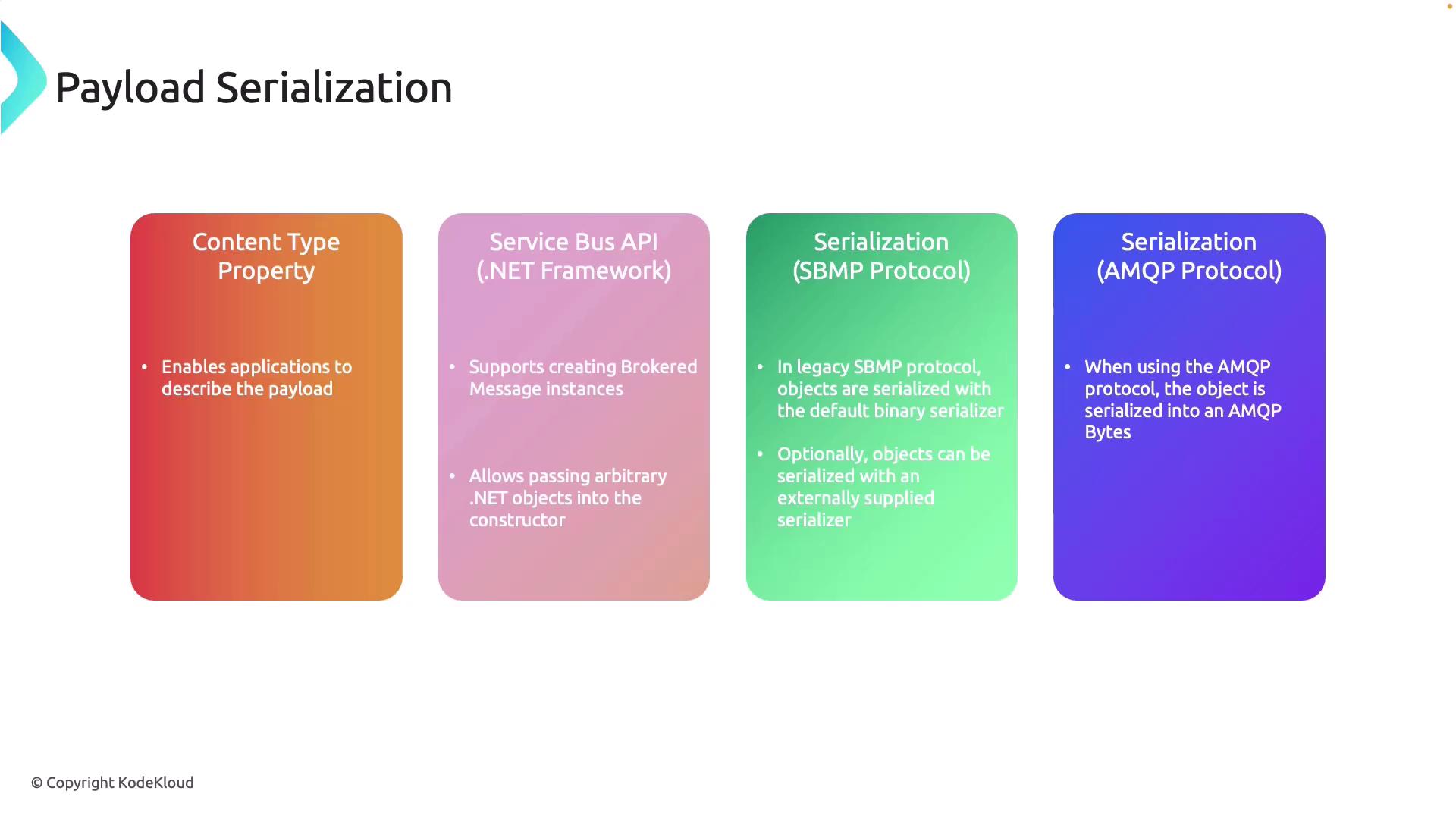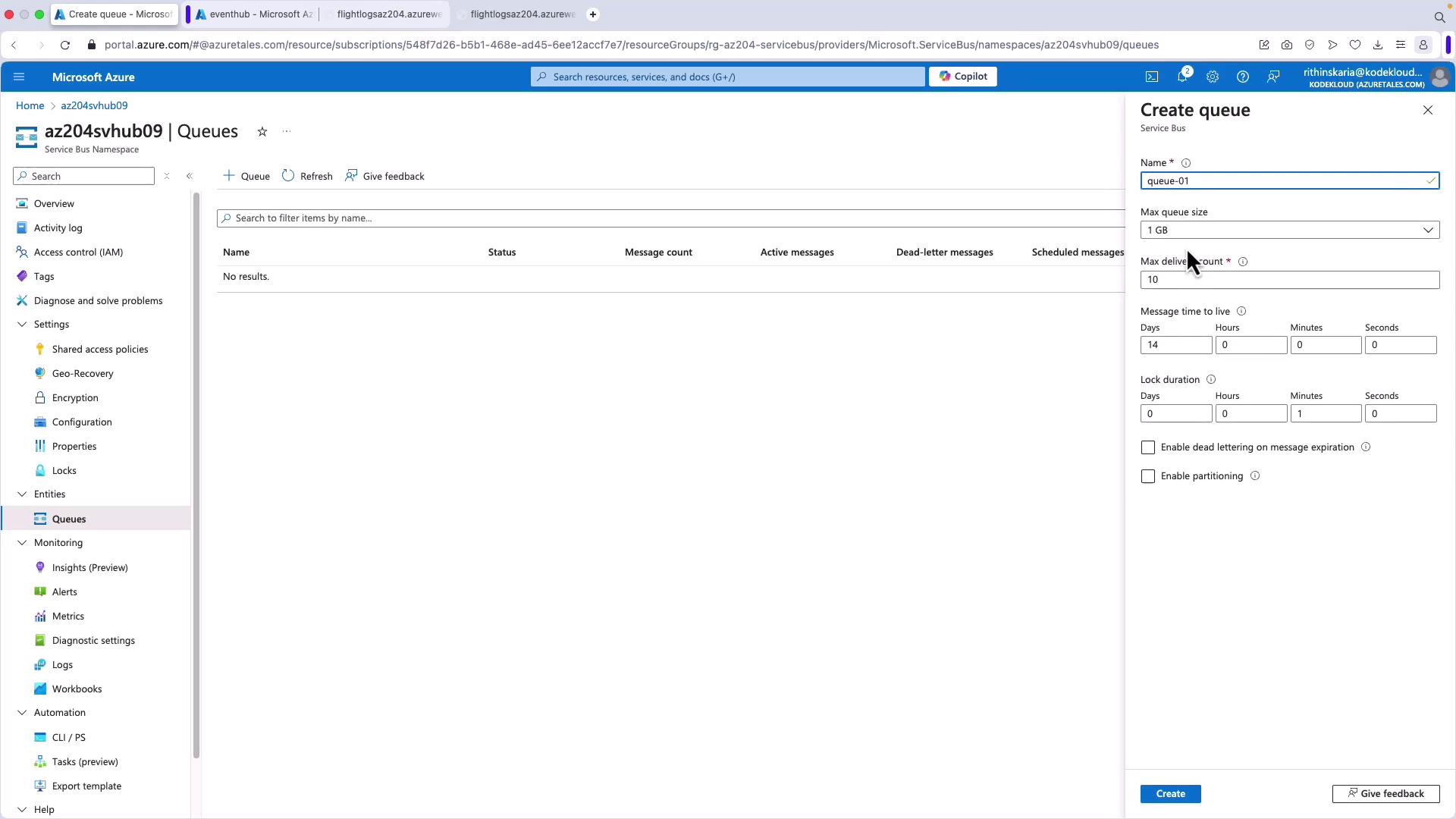AZ-204: Developing Solutions for Microsoft Azure
Discovering Azure Message Queues
Exploring Service Bus Message Payloads and Serialization
This article delves into two critical aspects of Azure Service Bus messaging: message routing with correlation patterns and payload serialization. By understanding these topics, you can design highly effective messaging systems that efficiently manage high volumes of data.
Message Routing and Correlation Patterns
Azure Service Bus supports various messaging patterns to suit different application requirements, from simple request replies to more complex workflows. Below are the key routing and correlation patterns you can leverage:
Simple Request/Reply
The Simple Request/Reply pattern involves a publisher sending a message to a queue where a consumer processes it and responds directly. This is ideal for scenarios requiring an immediate response, such as querying inventory status.
Multicast Request/Reply
In the Multicast Request/Reply pattern, a message is sent to a topic, and multiple subscribers independently process it. This pattern is useful when multiple systems need to act on the same information, such as when an update notification must be sent to several services.
Multiplexing
Multiplexing enables multiple streams of related messages to be processed through a single queue or subscription. For instance, an e-commerce system can handle both order and shipping messages in one flow, thereby improving processing efficiency.
Multiplexed Request/Reply
The Multiplexed Request/Reply pattern extends multiplexing by supporting multiple reply messages for each request within a stream. This pattern works well in complex workflows with multi-step interactions where each step may produce a distinct response.

Note
Understanding the different routing patterns helps you choose the best approach for your messaging needs, ensuring both efficiency and scalability in your system.
Message Serialization
Serialization is essential to converting objects to a format that can be transmitted over the network and then deserialized reliably on the receiving end. Azure Service Bus supports several serialization methods:
Content-Type Property
This property specifies the payload format (e.g., JSON or XML), allowing the receiver to deserialize messages correctly.
Service-Based API in .NET Framework
The Service Bus API for the .NET Framework allows you to create a brokered message by directly passing .NET objects. This approach simplifies sending complex objects by automatically converting them to the correct message format.
Legacy SBMP Protocol Serialization
With the legacy SBMP protocol, objects are serialized using a binary serializer. You also have the option to use a custom serializer, tailoring serialization to specific use cases.
AMQP Protocol Serialization
AMQP, an industry-standard protocol, serializes objects into a byte stream ensuring interoperability with various messaging systems that support AMQP.

Tip
Choosing the appropriate serialization method is crucial for ensuring that your messaging system is both efficient and robust. Evaluate your system's needs based on data complexity and interoperability requirements.
To summarize, selecting the right routing pattern and serialization method is key for achieving effective communication in Azure Service Bus. These techniques will help optimize both performance and scalability in your messaging solutions.
Azure Portal Walkthrough
Follow these steps to create a Service Bus instance and explore sending and receiving messages via the .NET SDK.
- Open the Azure Portal and search for "Service Bus."
- Create a Service Bus namespace with the following settings:
- Resource Group: RG-AZ204-ServiceBus
- Namespace Name: Choose a unique name (e.g., AZ204-SV-Hub09) to register under servicebus.windows.net.
- Tier: Basic (suitable for simple messaging scenarios)

- Navigate to the Advanced > Networking section and select public access (note that private endpoints require a higher tier).
- After validation, deploy the Service Bus.
- Once deployed, capture both the Service Bus name and the connection string (using either the root Shared Access Signature with manage, send, and listen permissions, or a custom one for specific actions).
Setting Up the Queue and Code Walkthrough
After deploying your Service Bus instance, create a queue (e.g., Q01) for your messaging operations. The default settings such as queue size, maximum delivery count, dead lettering, and partitioning are generally sufficient for initial testing.

Below is the code walkthrough for sending and receiving messages with the .NET SDK.
Main Application Code
This section prompts the user to choose between sending or receiving a message:
using System;
using System.Threading.Tasks;
using Azure.Messaging.ServiceBus;
class Program
{
private const string connectionString = "Endpoint=sb://az204svhub09.servicebus.windows.net/;SharedAccessKeyName=RootManageSharedAccessKey;SharedAccessKey=BbM4cPwJBpThed0w/oQULE5KLR3DvocM";
private const string queueName = "queue-01"; // Replace with your Queue name
static async Task Main(string[] args)
{
Console.WriteLine("Azure Service Bus Demo: Send or Receive Messages");
Console.WriteLine("Choose an option:");
Console.WriteLine("1. Send a message");
Console.WriteLine("2. Receive messages");
var input = Console.ReadLine();
if (input == "1")
{
await SendMessageAsync();
}
else if (input == "2")
{
await ReceiveMessagesAsync();
}
else
{
Console.WriteLine("Invalid input. Exiting...");
}
}
}
Sending a Message
The following method prompts the user for a message and sends it asynchronously:
static async Task SendMessageAsync()
{
await using var client = new ServiceBusClient(connectionString);
ServiceBusSender sender = client.CreateSender(queueName);
Console.WriteLine("Enter the message to send:");
string? messageBody = Console.ReadLine();
ServiceBusMessage message = new ServiceBusMessage(messageBody);
await sender.SendMessageAsync(message);
Console.WriteLine($"Sent message: {messageBody}");
}
Receiving Messages
This method sets up a processor to handle incoming messages and errors. It processes messages by converting them to strings and completes each message after processing:
static async Task ReceiveMessagesAsync()
{
await using var client = new ServiceBusClient(connectionString);
ServiceBusProcessor processor = client.CreateProcessor(queueName, new ServiceBusProcessorOptions());
processor.ProcessMessageAsync += MessageHandler;
processor.ProcessErrorAsync += ErrorHandler;
await processor.StartProcessingAsync();
Console.WriteLine("Receiving messages... Press any key to stop.");
Console.ReadKey();
await processor.StopProcessingAsync();
Console.WriteLine("Stopped receiving messages.");
}
static async Task MessageHandler(ProcessMessageEventArgs args)
{
string body = args.Message.Body.ToString();
Console.WriteLine($"Received message: {body}");
await args.CompleteMessageAsync(args.Message);
}
static Task ErrorHandler(ProcessErrorEventArgs args)
{
Console.WriteLine($"Error occurred: {args.Exception.Message}");
return Task.CompletedTask;
}
Running the Application
After saving your changes, run the application using the following command:
dotnet run
The console will display options to either send or receive messages:
Azure Service Bus Demo: Send or Receive Messages
Choose an option:
1. Send a message
2. Receive messages
When you opt for sending a message, enter your desired text (e.g., "Hello there!"). In a separate instance or after restarting the application, choose the receive option to view the message. The console output should resemble the following:
Sent message: Hello there!
And when receiving:
Receiving messages... Press any key to stop.
Received message: Hello there!
Pro Tip
Running both send and receive operations concurrently can help test and validate the end-to-end messaging flow in your application.
Next Steps
This demonstration covered the fundamentals of Azure Service Bus messaging. In future discussions, we will extend these concepts to explore Azure Blob Storage, further enhancing your cloud messaging and storage solutions.
Happy learning!
Watch Video
Watch video content